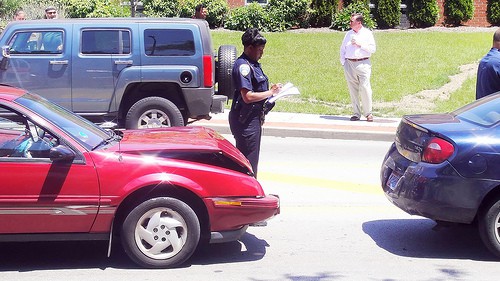Whiplash facts
3 Little Known Whiplash Facts
Whiplash facts are not common knowledge. There are many whiplash facts that the public is unaware of.
Chiropractic care isn’t typically associated with crisis, emergency or rescue medicine. However, in cases involving whiplash– especially those with chronic (or long lasting) whiplash-associated pain — research not only shows that conventional treatments are disappointing, but that chiropractic care may be a whiplash patient’s best option for full recovery.
Here are three little known facts about Whiplash, a set of symptoms which effect more than 1 million people annually, which may help you or someone you know:
First, whiplash can occur at very low speeds, even less than 5 mph.
Whiplash symptoms can include not only neck and shoulder pain, but also headaches, numbness, neck swelling, blurred vision and dizziness, and this condition can occur as a result of a “crash” so “minute” your car may walk away unscathed. Research has shown that crashes — especially rear crashes — occurring at even 2.5 mph can create whiplash and whiplash symptoms.
So, if you’ve had a “pain in the neck” or weird symptoms following that minor fender bender with your neighbor, you may need to be treated for whiplash.
X-rays may not show a fracture in whiplash patients.
Don’t rely on the all-important x-ray machine to diagnose you with whiplash. Typically, in whiplash patients, the x-ray will show that you have no fractures. It will take a trained eye to see that you may have what’s called a “straightening of the cervical curve,” which is common in whiplash patients.
Finally, research shows that in up to 93% of whiplash patients, Chiropractic care can help.
In an 1999 study published in the Journal of Orthopedic Medicine, chiropractic care was actually described as the “only proven effective treatment” for chronic whiplash symptoms.
This makes sense as Chiropractic physicians are trained to diagnose and treat the injuries and symptoms associated with whiplash. We not only treat your joints and soft tissues, but we can also help you with effective home care options to help speed your recovery.
In this 1999 study, patients received an average of 19 adjustments over a 4 month period and the results showed that 93% of patients studied saw an improvement in their whiplash symptoms. If you or someone you know is suffering from whiplash symptoms, don’t wait. Schedule an appointment with Dr. Maggio today.
Whiplash can occur any time the head whips forward and back quickly, causing over-extension and injury to muscles, soft tissues, and the vertebrae that make up the neck. Clinically, whiplash is a flexion-extension injury.
What causes whiplash?
Whiplash is usually associated with car accidents, but it can occur in any sudden stop or collision at a speed of more than 3.5 miles an hour. This includes bicycle collisions, or even things such as roller coasters or playground swings.
This means that in some cases, the injured person doesn’t suspect that whiplash is the cause of their pain.
Adding to the problem is that whiplash can happen so quickly that the brain slams into the skull and the person blacks out for a fraction of a second. If his head goes back and forth only once, he may have no recollection that whiplash even happened! (In cases in which the whipping motion happens twice or more, as during more serious accidents, victims are more likely to remember.)
So during a medical checkup after an auto accident that happened at low-impact speed, a patient may deny that whiplash occurred (because there’s no memory of it) and may not get it treated at all.
All of this is a problem because there’s only a short window of time in which the damage from a whiplash injury can be repaired.
The 28-day window
A whiplash injury often results in the tearing and bleeding of muscles, which eventually attempt to repair themselves. But if the whiplash injury doesn’t receive proper treatment, scar tissue can form in places that actually interfere with the function of the muscles.
There’s a window of about 28 days before this scar tissue becomes permanent.

Mark Turnauckas via photopin cc
That’s why it’s so important to get checked for whiplash after any accident, even if you’re not sure whiplash occurred.
A simple chiropractic examination, including x-rays and a range of motion test, can confirm whether corrective treatment is needed.
Unfortunately, many people miss this critical period of healing time. Often people try to treat their neck pain with over-the-counter medication. These types of painkillers can only be taken for two weeks, but whiplash pain will still remain. The next step most people take is to see a doctor and request prescription medication for another couple of weeks.
By the time they realize a different method of treatment may be needed, the scar tissue may already be formed. The injury will be harder to treat, with less effective results than what might have been.
Whiplash and insurance
Another reason to get checked for whiplash immediately after an accident involves insurance coverage. Auto insurance is designed to protect you from the cost of damage from an accident (especially if the other driver was at fault), and medical expenses are often covered. However, with many policies there’s only a small window of time in which you can make a claim for whiplash injuries.
This makes sense on the part of the insurance industry, of course. If at the time of the accident you make no mention of injury, and then a month or two later you try to make a claim for whiplash—that looks like potential fraud.
An early examination
If you’ve been in an accident of any sort, whether in a motor vehicle or in something smaller, be sure to get an examination immediately afterward. And even if you’re not feeling much neck pain at the time, ask to be checked specifically for whiplash.
If you’d like to schedule an examination at our office, you can call us at 757.473.9900, or use our appointment form. Getting treatment early can save you a lot of pain down the road and result in better outcomes for your health!


Leave A Comment